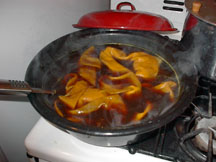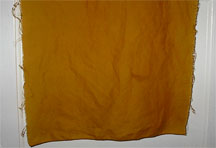Using Plants as Natural Dyes
Abstract
using plant pigments to dye animal and plant fibers.
Introduction
Creating and using plant-based-dyes is a wonderful way to gain an understanding of the biology and the chemistry at work in the plants around us.
Sources of natural dyes are everywhere. Dyes can be extracted from roots, foliage, nuts, berries and flowers. Until the mid-19th century plants were the primary source of dye. The process of natural dyeing became obsolete with the discovery that dye pigments could be produced through modern chemistry. Dyes produced by chemical means are more easily transferred to fibers, do not require as much time in preparation, and stand up better to repeated washing and exposure to sunlight.
Today natural sources of dyes are used by artisans and crafters. Natural dyes are desirable mainly because of the quality of color that can be created with them. Dyes extracted from plants contain many different pigments, and thus are not the "pure" forms of pigment used in today's chemical dyes. These impurities create rich and sometimes unexpected color, that can never be duplicated. For many the process of extracting the dyes from their natural sources connects them to their work, and gives them control over each step of creation.
There are many methods used to extract dyes from plants and use them to color fibers. For the purposes of this web page I will be describing the mordant method used to dye cotton fibers.
The Dyeing Process
Gathering Materials
Dyes are produced by plant pigments. Some plants, such as indigo and madder (which are perhaps the two most famous dye plants), contain far greater amounts of pigment than others. The amount of pigment in each of plant is dependent not only on the genetics of each plant, but also the stage of development, and growing conditions.
(When gathering materials the Bibliography and Web page references are good ways to find out about the different types of dye plants. Take into consideration which plants are available and the safety precautions you need to take as some dye plant are poisonous.)
For my dye-bath I used:
- Onions skins
- Marigold blossoms (Tagetes erecta, Tagetes patula)
- Tansy (Tanacetum vulgare)
- Solidago (Solidago spp.)
- Chrysanthemum blossoms (Chrysanthemum morifolium)
- Sunflower heads (Helianthus annuus)
The Dye-Bath
Plant material in bowl before chopping.
Plant material ready to be simmered.
On the spoon you can see the dye
pigments already beginning to
transfer to the water.
In this dye-bath some of the active pigments are flavonoids called, quercitin and chalcones. The function of flavonoids is not completely understood, but it is known that they absorb UV-B light which plays a role in the defense and reproduction functions of a plant.
To Make the Dye-Bath
- Remove the desired portion of the plant
- Chop or tear the blossoms, leaves, etc. apart to expose more surface area
- Combine in a large kettle
- Add enough water to cover the plant material
- Simmer on range until the plant material looks faded and dye has transferred to the water (about 1 hour)
- Strain out left-over plant material and discard
- The remaining liquid is your dye
Preparing the Fibers
Types of Fibers
There are three general types of fibers; synthetic, animal and plant. Natural dyes do not adhere to synthetic fibers. Animal fibers are made up of protein, which is loosely structured and interacts well with other substances. Plant fibers are made of cellulose, which is more tightly structured and does not like to interact with other substances. (If you are using animal fibers please use a reference source as the following steps will vary.)
Washing the fibers
Simmer the cotton material in a solution of dish soap. This removes any oil, wax, or dirt that might interfere with the dye adhering to the fibers. Risne well.
Mordanting fibers
Mordanting fibers causes the dye to be chemically trapped on the fibers, so the dyed fabric will not loose its color. Mordanting, put simply it means electrically charging the material to be dyed with a metal cation. This cation then attracts and traps the color.
To mordant the fibers:
- Fill a kettle with 2 quarts water
- Add 1 Tb alum and 1 tsp baking soda
- Add cotton material
- Bring to a boil and simmer for 2 hours
- Let cotton material cool off and soak in alum solution for several hours
Dyeing
-
Place the cotton material in the prepared dye-bath
-
Bring dye-bath to a boil for 5 minutes
-
Simmer for 2 hours, stirring occasionally
-
Let cotton material soak overnight
-
Take cotton material out of dye-bath
-
Drain off excess dye
-
Rinse thoroughly
-
Allow to dry
.

Fabric just beginning to
simmer in dye-bath.

Final color of the cotton material
after a thorough rinsing.
(Beginning fabirc was bleached white.)
Bibliography
Buchanan, Rita. A Weaver's Garden: Growing Plants for Natural Dyes and Fibers. Dover ed. 1999.
Lesch, Alma. Vegetable Dyeing. Watson-Guptill Publications. 1970.
Web site Links
Potential for Colourants for Plant Sources in England and Wales
A research paper that provides an explanation of chemical sources for pigments.
KOEK Homepage
Discusses the quality of different processes used in natural dyeing.
Botanical.com
An index of descriptions and properties of different plants.
Maiwa Handprints
A source for buying natural dye pigments, and links to other information on natural dyeing.
Return to the top of the page
Return to the beginning of the dyeing process